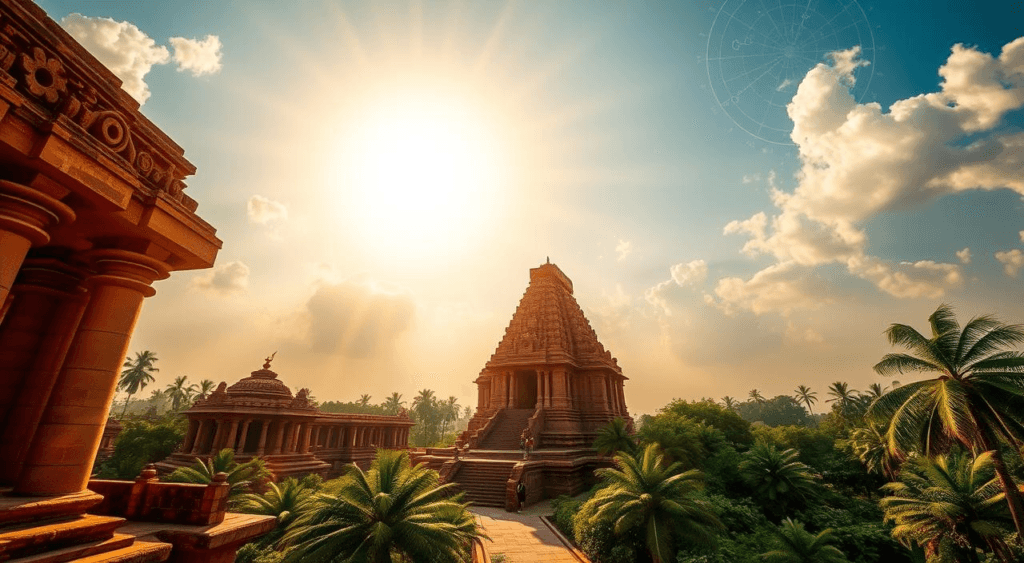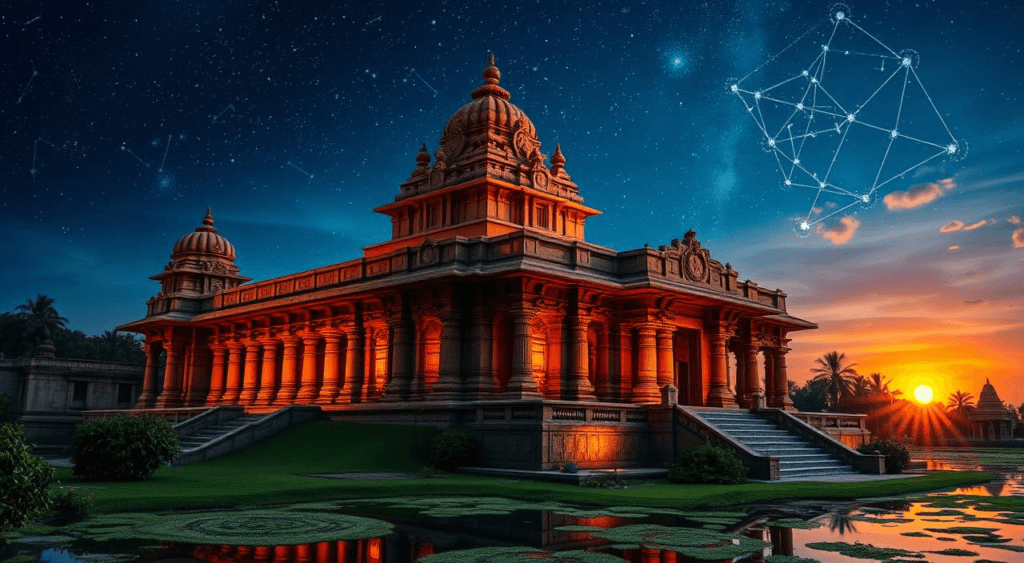
Table of Contents
Discover the science behind Konark Sun Temple solar energy ,astronomy mystery of Konark Sun Temple
The Konark Sun Temple in Odisha, India, is a marvel of ancient architecture. It combines architecture, astronomy, and science, especially in its use of solar energy. Built in the 13th century, it shows the advanced knowledge of ancient Indians in solar energy and astronomy.
The temple’s grandeur and mysteries are awe-inspiring. It invites us to explore its science and significance. The Konark Sun Temple is a prime example of ancient Indians’ use of solar energy and astronomy.
A breathtaking view of the Konark Sun Temple, showcasing intricate stone carvings and its impressive chariot-like structure, illuminated by golden sunlight. Rays of solar energy emanating from the sun above, casting dynamic shadows across the temple’s ornate details. A celestial map in the sky, hinting at ancient astronomical knowledge, with stars and constellations visible around the sun. Lush greenery surrounding the temple, blending nature with architectural marvel, evoking a sense of harmony between science and spirituality.
Studying the Konark Sun Temple reveals insights into its construction. It shows the ancient Indians’ understanding of solar energy and astronomy. This makes it a key subject for those interested in architecture, astronomy, and science, especially solar energy.
Introduction to the Konark Sun Temple
The temple’s design and construction show a deep understanding of solar energy and astronomy. It demonstrates the advanced knowledge of ancient Indians in these areas. By exploring the science behind the Konark Sun Temple, we can appreciate the ingenuity and skill of its creators.
Key Takeaways
- The Konark Sun Temple is a prime example of ancient Indian architecture that showcases a blend of science, astronomy, and solar energy.
- The temple’s design and construction reflect a deep understanding of solar energy and astronomy mystery.
- The study of the Konark Sun Temple offers insights into the astronomy mystery and solar energy principles that guided its construction.
- The temple is a significant subject of study for those interested in the intersection of architecture, astronomy, and science.
- The Konark Sun Temple demonstrates the advanced knowledge and skills of the ancient Indians in harnessing solar energy and understanding astronomy mystery.
- The temple’s unique approach to solar energy and astronomy mystery makes it a fascinating subject for exploration and study.
The Marvel of Konark Sun Temple: An Architectural Wonder
The Konark Sun Temple showcases ancient Indian architecture’s genius. Located in Odisha, India, it highlights the area’s rich culture. Its detailed carvings, tall towers, and beautiful sculptures make it a key spot for history, architecture, and culture lovers.

A majestic view of the Konark Sun Temple at sunrise, showcasing its intricate carvings and sculptures, surrounded by lush greenery, with rays of sunlight illuminating the temple’s chariot wheels, reflecting ancient Indian architectural styles and astronomical features.
The temple’s design stands out for using local materials like stone and brick. It also features traditional Indian design elements, like the wheel and the lotus flower. These elements enhance the temple’s beauty and show the region’s rich cultural traditions.
Historical Significance and Background
Built in the 13th century, the Konark Sun Temple was a project of King Narasimhadeva I. It’s a top UNESCO World Heritage site in India, drawing millions yearly.
The Temple’s Cultural Impact
The temple deeply influences local culture, with many festivals and traditions tied to it. Its stunning architecture and setting make it a favorite for cultural and spiritual tourism.
UNESCO World Heritage Status
In 1984, UNESCO named the Konark Sun Temple a UNESCO World Heritage site. This recognition boosts its conservation and preservation. It ensures the temple remains a crucial part of India’s cultural heritage for future generations.
Unraveling the Solar Mysteries of Ancient India
Ancient Indian astronomy was very advanced. They knew a lot about the sun’s movements and big events in the sky. The Konark Sun Temple shows their deep knowledge of the sun. Studies on ancient Indian astronomy show they understood the sun’s path well.
The temple’s design shows they knew a lot about the sun. They understood how the sun moves and affects the world. Some important things they knew include:
- Understanding of planetary movements and celestial navigation
- Knowledge of solar eclipses and their significance
- Development of calendars based on solar cycles
A mesmerizing representation of ancient Indian astronomy, featuring the Konark Sun Temple illuminated by sunlight at dawn, intricate stone carvings depicting celestial bodies, astrological symbols in the foreground, a vibrant sunrise casting warm hues across the temple’s structure, and a starry night sky with constellations visible above, all surrounded by lush greenery and tranquil waters reflecting the architecture.
Exploring solar mysteries in ancient Indian astronomy helps us appreciate their culture. By looking at the Konark Sun Temple, we learn about their knowledge of the universe. This helps us understand the principles behind its construction.

The Architectural Brilliance of the Temple Complex
The Konark Sun Temple shows the skill of ancient Indian architects and engineers. Its design and construction show a deep understanding of architectural techniques and ancient Indian engineering. The use of stone and brick shows a commitment to sustainability.
The temple’s construction used advanced architectural techniques. It includes intricate carvings and sculptures. The temple can withstand natural disasters like earthquakes and cyclones. This is thanks to ancient Indian engineering principles.
Construction Techniques
The ancient Indian builders’ skill is evident in the temple’s construction. They used several techniques:
- Interlocking stones for a strong structure
- Intricate carvings and sculptures from local materials
- Advanced architectural techniques like load distribution
Material Selection and Usage
The choice and use of materials in the temple’s construction are key to its architectural brilliance. Locally sourced materials like stone and brick show sustainability. These materials were chosen for their durability and strength.
| Material | Usage |
|---|---|
| Stone | Used for the temple’s structure and carvings |
| Brick | Used for the temple’s walls and foundation |
The Famous Konark Sun Temple Wheel: Beyond Decoration
The Konark Sun Temple Wheel is a famous part of the temple. It’s often seen as a symbol of the sun’s power. But, its importance goes beyond just being pretty.
The wheel is a work of ancient Indian mathematics. It shows off geometric patterns and numbers with deep meaning.
Research into the wheel’s math and symbols shows a deep grasp of astronomical principles. The design isn’t just for looks. It also shows the sun’s journey and its effect on us. The Konark Sun Temple Wheel proves ancient Indian mathematicians and astronomers were very advanced.
The wheel’s design comes from complex math. It’s a great example of ancient Indian mathematics in action. The use of shapes and numbers makes it even more interesting.
By studying the Konark Sun Temple Wheel, we learn more about ancient Indian knowledge. This knowledge was very advanced.
Some key features of the Konark Sun Temple Wheel include:
- Geometric patterns that represent the sun’s movement
- Numerical symbolism that reflects the sun’s power and significance
- Astronomical principles that guide the wheel’s design
These features make the Konark Sun Temple Wheel a unique and fascinating example of ancient Indian mathematics and astronomy.
Solar Energy Integration in Ancient Architecture
The Konark Sun Temple is a prime example of solar energy integration in ancient structures. Its design captures the sun’s power using solar alignment principles. This shows ancient people’s grasp of the sun’s movement.
Solar Alignment Principles
The temple’s layout follows solar alignment. This means its structures are set to match the sun’s path. This alignment helps capture solar energy for tasks like heating and lighting.
Shadow Patterns and Time Measurement
The temple also uses shadow patterns for timekeeping. Shadows from the temple help measure time, a method still used today. This shows the creativity and ingenuity of ancient cultures.
Here is a table summarizing the key principles of solar energy integration in ancient architecture:
| Principle | Description |
|---|---|
| Solar Alignment | Precise positioning of structures to align with the sun’s movement |
| Shadow Patterns | Use of shadows cast by structures to measure time |
Astronomical Precision in Temple Design
The Konark Sun Temple shows astronomical precision in ancient Indian architecture. Its design reflects a deep understanding of ancient Indian astronomy. It aligns with the sun’s path during the summer solstice.
Some key features of the temple’s design that demonstrate astronomical precision include:
- The temple’s main entrance, which is aligned with the sunrise on the summer solstice
- The intricate carvings and sculptures that depict various celestial bodies and events
- The use of shadows and light to measure time and track the movement of celestial bodies
The temple’s design reflects the advanced knowledge of ancient Indians. It is not just beautiful but also shows a deep understanding of
The Konark Sun Temple is a remarkable example of how ancient Indian architects were able to combine art, science, and spirituality to create a truly unique and awe-inspiring structure.
Studying the Konark Sun Temple’s design gives us insights into ancient Indian astronomy. By looking at its architecture, we appreciate the ingenuity of ancient Indian architects.
Mathematical Marvels of the Konark Wheel
The Konark Sun Temple Wheel is a true marvel of ancient Indian architecture. It shows mathematical marvels that amaze both art lovers and mathematicians. The wheel’s design is a testament to the creativity of its makers. They combined geometric patterns to create a stunning and mathematically precise work of art.
Looking closely at the wheel, we see a mix of geometric patterns like triangles, circles, and squares. These patterns are more than just decorations. They show the math behind the wheel’s design. The use of mathematical marvels in its making shows the advanced math and astronomy knowledge of ancient India.
- Intricate carvings that depict various geometric patterns
- A complex system of gears and wheels that demonstrate a deep understanding of mathematical marvels
- A precise alignment of the wheel’s components, which reflects a sophisticated grasp of astronomy and mathematics
The Konark Sun Temple Wheel is a great example of combining mathematical marvels and geometric patterns. It’s a work of art that is both beautiful and thought-provoking. As we admire the wheel’s design, we remember the ingenuity and creativity of the ancient Indians who made it.
| Feature | Description |
|---|---|
| Geometric Patterns | Intricate carvings that depict various geometric shapes |
| Mathematical Marvels | A complex system of gears and wheels that demonstrate a deep understanding of mathematical principles |
| Precision Alignment | A precise alignment of the wheel’s components, which reflects a sophisticated grasp of astronomy and mathematics |
Ancient Indian Astronomical Knowledge
Ancient Indian astronomy was very advanced. They knew a lot about the stars and planets. They could predict when important events in the sky would happen.
They also made solar calendars. This was based on the sun and stars’ movements. It helped them keep track of time and predict big events.
Celestial Navigation Systems
Celestial navigation was key in ancient Indian astronomy. It helped them sail the seas and understand the sky. Some important parts of this include:
- Tracking the movements of the sun and the stars
- Predicting astronomical events, such as eclipses and planetary alignments
- Developing accurate calendars and time-keeping systems
Our understanding of the universe owes a lot to ancient Indian astronomy. They studied the stars and planets deeply. Their work has shaped modern astronomy and our view of the universe.
Myths and Legends Surrounding the Temple
The Konark Sun Temple is filled with myths and legends. These stories have been passed down for generations. They give us a peek into the beliefs of those who built and worshipped here.
One famous myth is about King Langula Narasimha Deva. He built the temple to honor the sun god. Another legend says the temple was built in one night by skilled artisans.
These myths and legends are a big part of the temple’s history. They show us the lives and beliefs of those who came before. They still captivate visitors today.
- The story of the temple’s construction, which was said to have been completed in a single night
- The legend of King Langula Narasimha Deva, who built the temple to appease the sun god
- The myth of the temple’s magical powers, which were said to have the ability to heal and protect
These myths and legends show the temple’s lasting cultural importance. They continue to inspire and amaze visitors from all over.
Scientific Principles Behind Temple Architecture
The Konark Sun Temple shows how ancient India understood science. Its design uses scientific principles that show a deep grasp of engineering and sound.
The temple’s architecture is a blend of scientific principles and engineering. It uses special materials and designs to stand strong against nature. This shows a clear understanding of engineering concepts.
Engineering Concepts
The temple’s design includes arches, domes, and vaults for support. Its foundation is made to handle earthquakes, keeping the structure stable.
Acoustic Properties
The temple’s design also focuses on acoustic properties. It uses materials and shapes to improve the worship experience. This makes the sound clearer and more immersive for visitors.
The Konark Sun Temple’s design combines scientific principles and engineering concepts. This has made a structure that is beautiful, functional, and long-lasting. It shows the skill and creativity of ancient Indian engineers and architects.
The Role of Sacred Geometry
Sacred geometry is key in ancient Indian architecture, like the Konark Sun Temple. It’s based on the idea that certain shapes and patterns have spiritual meaning. These patterns show the harmony and balance found in nature.
In sacred geometry, these patterns help create structures that mirror the universe’s principles.
The use of sacred geometry in ancient Indian architecture is clear in the Konark Sun Temple. You can see it in the detailed carvings, symmetrical designs, and exact measurements. These show the ancient architects’ advanced math skills and their deep spiritual understanding.
- Use of geometric shapes to represent spiritual concepts
- Application of mathematical ratios to achieve balance and harmony
- Incorporation of natural patterns and shapes into architectural design
The Konark Sun Temple’s design shows how sacred geometry brings unity and cohesion. It connects the structure with its surroundings.
The use of sacred geometry in ancient Indian architecture is a testament to the ingenuity and spiritual depth of its creators, and continues to inspire wonder and awe in all who experience it.
Modern Scientific Studies of Temple Features
Recent modern scientific studies have shed new light on the Konark Sun Temple. Researchers use archaeological findings and advanced technology to study it. This helps us understand its structure and history better.
Uncovering the Past
Important archaeological findings include ancient artifacts and inscriptions. These give us a glimpse into the temple’s past. Tools like ground-penetrating radar and thermal imaging help find these treasures.
Contemporary Research
Today’s research sheds light on the Konark Sun Temple. By examining its architecture and design, we learn more. Key areas of study include:
- The use of solar alignment principles in the temple’s design
- The significance of the temple’s geometric patterns and numerical symbolism
- The role of the temple in ancient Indian astronomy and astrology
Conservation Efforts and Scientific Challenges
Keeping the Konark Sun Temple safe is a big job. It needs careful conservation efforts and tackling scientific challenges. The Indian government and global groups are working hard. They aim to shield the temple from disasters and harm caused by people.
Some important conservation efforts include:
- Fixing the temple to stop it from getting worse
- Keeping it safe from nature’s damage like erosion and pollution
- Starting green tourism to lessen the impact of visitors
But, the temple still has scientific challenges. These are things like figuring out how climate change affects it. And finding ways to keep the detailed carvings and sculptures safe.
Scientists are tackling these issues. They’re studying the temple’s materials and creating new ways to save it. By mixing conservation efforts with science, we can keep the Konark Sun Temple safe for a long time.
| Conservation Effort | Scientific Challenge |
|---|---|
| Restoration of the temple’s structure | Understanding the effects of climate change |
| Protection from environmental factors | Developing effective preservation methods |
Impact on Modern Architectural Science
The Konark Sun Temple has greatly influenced modern architecture. It has inspired new designs and ways to build. Architects today are fascinated by its mix of function and beauty.
Modern architects can learn a lot from the Konark Sun Temple. Here are some key lessons:
- The importance of sustainability in building design
- The use of local materials to reduce environmental impact
- The incorporation of traditional techniques to create unique and functional spaces
The impact on modern architecture is clear in many buildings inspired by the Konark Sun Temple. Architects are always looking to improve and innovate, and the temple’s design is a big part of that.
By studying the Konark Sun Temple, architects can learn a lot about architectural science. It shows how important it is to build sustainable and functional buildings. The temple continues to inspire architects as they evolve their craft.
Conclusion: Bridging Ancient Wisdom with Modern Understanding
The Konark Sun Temple is a bridge between ancient wisdom and today’s world. It shows us the advanced knowledge of ancient India. Its design teaches us lessons for today’s problems.
The temple’s use of solar energy and astronomy is amazing. It shows our ancestors’ genius. We learn to appreciate ancient architecture and its link to nature.
The Konark Sun Temple inspires people everywhere. It reminds us that old wisdom can help us today. By connecting ancient knowledge with science, we make this treasure valuable for all time.
FAQ
What is the historical significance and background of the Konark Sun Temple?
The Konark Sun Temple is in Odisha, India. It’s from the 13th century. It shows the advanced skills of ancient Indians.
The temple is famous for its design. It’s a key cultural and religious site.
How has the Konark Sun Temple impacted the cultural landscape of the region?
The temple has deeply influenced the area. It symbolizes ancient India’s art and spirituality. Being a UNESCO World Heritage site highlights its global importance.
What are the solar mysteries and astronomical principles embedded in the temple’s design?
The temple shows ancient India’s astronomy knowledge. Its design aligns with solar movements. It also measures time through shadows.
What are the architectural techniques and innovations showcased in the temple complex?
The temple’s architecture is a marvel. It uses advanced construction methods and materials. Ancient Indian architects and engineers showed great skill here.
What is the significance of the Konark Sun Temple Wheel?
The Wheel is more than a decoration. It shows advanced math, like geometric patterns. It links to ancient astronomy and math.
How does the Konark Sun Temple demonstrate the advanced astronomical knowledge of ancient India?
The temple shows ancient Indians’ deep astronomy knowledge. It has systems for navigation and a solar calendar. It also includes astronomical events in its design.
What are the myths and legends surrounding the Konark Sun Temple?
The temple has many myths and legends. These stories add to its cultural value. They reflect the beliefs of those who built and worshipped here.
What are the scientific principles and engineering concepts behind the temple’s architecture?
The temple’s design is based on science. It shows a deep understanding of engineering and sound. Ancient Indian architects and engineers were very advanced.
How does sacred geometry play a role in the design of the Konark Sun Temple?
Sacred geometry is key in the temple’s design. It reflects ancient Indian philosophy and spirituality. The use of sacred geometry shows the temple’s holistic design.
What are the latest scientific studies and archaeological findings related to the Konark Sun Temple?
New studies and findings have revealed more about the temple. Advanced technologies have analyzed its structure and history.
What are the conservation efforts and scientific challenges faced in preserving the Konark Sun Temple?
Saving the temple is crucial. Efforts are ongoing to address challenges. Innovative solutions are used to protect it for the future.
How has the Konark Sun Temple influenced modern architectural science and design?
The temple has inspired modern architecture. It has led to new designs and building methods. Its architecture teaches us about sustainable building.
Also Read This ;
10 priceless verses from Shri Krishna’s “Karmanyevadhikaraste Ma Faleshu Kadachan


